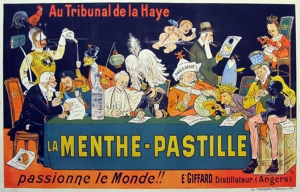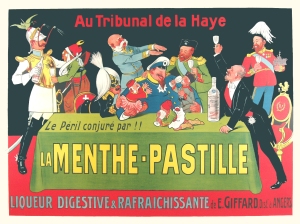Eugene Oge and La Menthe Pastille
August 24, 2012 § 2 Comments
The greatest thing about collecting original posters is how much we get to learn about 19th and 20th century history just by soaking up these colorful collectibles. I recently found a Menthe Pastille poster by Eugene Oge which struck me as just such an opportunity to learn more about the period leading up to World War I. It is uncommon for a poster artisit to uses political humour in an advertising poster—politics can be too controversial, and might alienate the consumer from a brand, but in this example, Oge does a great job creating caricatures of the world’s leaders.
The poster from 1904 shows a total of 13 figures, each representing something different and interacting together to show political situations in Europe. They sit at a table with a tablecloth decorated with the large text of “La Menthe-Pastille.” All the figures look as if they are in peaceful talks with each other. On the left, Oge depicts William II serving a drink to the Japanese Emperor, Matsuhito. In the foreground, the Emperor of France is being comforted about his inability to produce a male heir. The Japanese Emperor stands behind the Emperor of France, even though they are enemies, but the Emperor of France does not seem concerned. In the middle of the table, the newly chosen Catholic Pope puts his arm around King Emmanuel III of Rome. Next to King Emmanuel III on the right is Edward VII, King of the United Kingdom, who smokes and gazes at the globe that the man on his right, Jacques Lebaudy, gazes at as well. Behind those two figures is Leopold II of Belguim at an image of his “muse” Cleo de Merode. Next, to the right, is Alfonso XIII who sits regally, wearing his crown, as he recently was coronated King of Spain. Lastly, below him sits Uncle Sam with a small African American baby on his lap.
In the 1913 poster, the figures are fewer, and some major players in the European situation are either out of power or not longer alive. Only 10 people now populate the poster. **Those missing are Emile Loubet, the French Emperor, and two people who had since died: Edward VII and Leopold II. The situation is much more tense here, and inflammatory situations are shown here that La Menthe-Pastille, William II tries to become allies with the Ottoman Sultan Mehmet V. In the center of the poster, the Kaiser Frederic William, plays with three small childlike figures who represent the Kings of Serbia, Bulgaria, and Greece. This poster again tells people to drink La Menthe Pastille to inject tranquility and ease into their lives, but in 1913, the statement is more adamant.
Sources
* Eugene Oge: Affichiste , Anne-Claude Lelieur et Raymond Bachollet, published 1998 by Agence Culturelle de Paris. p. 214-215)
** Eugene Oge: Affichiste , Anne-Claude Lelieur et Raymond Bachollet, published 1998 by Agence Culturelle de Paris.pages 224-225)
This post was written by Karlie Drutz, San Francisco State Museum Studies Student and VEP intern and Elizabeth Norris, Owner, Vintage European Posters.
See our entire collection of original vintage posters from Europe and the United States at www.vepca.com or visit us on Tuesdays or by appointment at our Berkeley Showroom 2201 Fourth Street in Berkeley, CA



Very nicely researched with detailed writing about the characters seen in the 1904 poster version.
for your information, the last emperor of France was Napoleon III, so in 1904 ,a President is ruling France, not an Emperor.
this is a very nice that was developed in various sizes ,even on metal sign and as paper fan and postcard.I am in the possession of the very large version (198x373cm that’s very big)